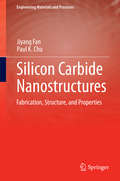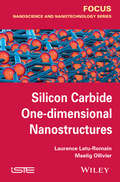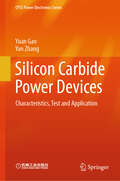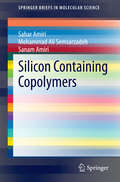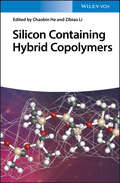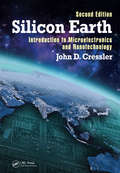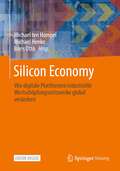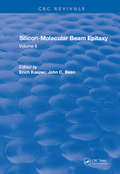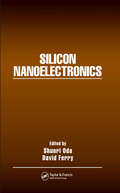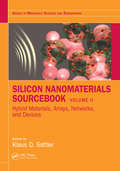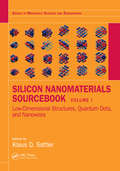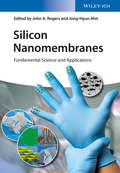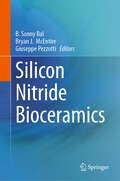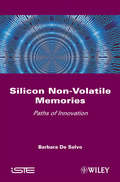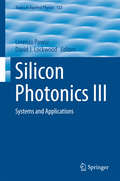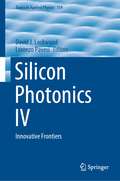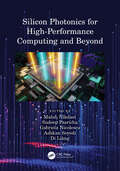- Table View
- List View
Silicon Carbide Nanostructures
by Jiyang Fan Paul K. ChuThis book brings together the most up-to-date information on the fabrication techniques, properties, and potential applications of low dimensional silicon carbide (SiC) nanostructures such as nanocrystallites, nanowires, nanotubes, and nanostructured films. It also summarizes the tremendous achievements acquired during the past three decades involving structural, electronic, and optical properties of bulk silicon carbide crystals. SiC nanostructures exhibit a range of fascinating and industrially important properties, such as diverse polytypes, stability of interband and defect-related green to blue luminescence, inertness to chemical surroundings, and good biocompatibility. These properties have generated an increasing interest in the materials, which have great potential in a variety of applications across the fields of nanoelectronics, optoelectronics, electron field emission, sensing, quantum information, energy conversion and storage, biomedical engineering, and medicine. SiC is also a most promising substitute for silicon in high power, high temperature, and high frequency microelectronic devices. Recent breakthrough pertaining to the synthesis of ultra-high quality SiC single-crystals will bring the materials closer to real applications. Silicon Carbide Nanostructures: Fabrication, Structure, and Properties provides a unique reference book for researchers and graduate students in this emerging field. It is intended for materials scientists, physicists, chemists, and engineers in microelectronics, optoelectronics, and biomedical engineering.
Silicon Carbide One-dimensional Nanostructures
by Laurence Latu-Romain Maelig OllivierDedicated to SiC-based 1D nanostructures, this book explains the properties and different growth methods of these nanostructures. It details carburization of silicon nanowires, a growth process for obtaining original Si-SiC core-shell nanowires and SiC nanotubes of high crystalline quality, thanks to the control of the siliconout-diffusion. The potential applications of these particular nano-objects is also discussed, with regards to their eventual integration in biology, energy and electronics.eventual integration in biology, energy and electronics.
Silicon Carbide Power Devices: Characteristics, Test and Application (CPSS Power Electronics Series)
by Yuan Gao Yan ZhangThis book provides comprehensive technical information on SiC power devices from multiple perspectives, covering topics from device research and development to system applications. Chapters 1 to 4 focus on the characteristics of SiC devices, initially outlining the limitations of Si power devices and explaining why SiC has superior properties at the material level. It then offers updates on the latest developments in the SiC industry chain and products innovations, along with a detailed discussion of the characteristics and specifications of SiC Diodes and MOSFETs. Chapters 5 and 6 zoom in on SiC device testing and evaluation techniques, including CP testing, FT testing, system application testing, reliability assessment, failure analysis, and double-pulse testing. Chapters 7 to 12 focus on SiC device application technology, addressing common challenges in real applications and providing solutions. This includes voltage spikes during turn-off, crosstalk, common-mode current, common-source inductance, and driver circuits, concluding with case studies of SiC device applications in various scenarios. The book can serve as a textbook for higher education and vocational training, as well as a reference material for engineers in the power semiconductor and electrical electronics industries. To make the book genuinely helpful for readers, the authors have invested significant effort in content and data selection. First, the chosen technical points come from real-world requirements in device R&D and applications. Second, the book emphasizes practicality while integrating cutting-edge developments, detailing research outcomes with industrial potential. Third, the book offers a wealth of data and waveforms, most of which are actual measurements, to bridge the gap between theory and practice. Lastly, extensive further reading materials are provided at the end of each chapter for broader and deeper exploration.
Silicon Containing Copolymers
by Sahar Amiri Mohammad Ali Semsarzadeh Sanam AmiriSilicones have unique properties including thermal oxidative stability, low temperature flow, high compressibility, low surface tension, hydrophobicity and electric properties. These special properties have encouraged the exploration of alternative synthetic routes of well defined controlled microstructures of silicone copolymers, the subject of this Springer Brief. The authors explore the synthesis and characterization of notable block copolymers. Recent advances in controlled radical polymerization techniques leading to the facile synthesis of well-defined silicon based thermo reversible block copolymers are described along with atom transfer radical polymerization (ATRP), a technique utilized to develop well-defined functional thermo reversible block copolymers. The brief also focuses on Polyrotaxanes and their great potential as stimulus-responsive materials which produce poly (dimethyl siloxane) (PDMS) based thermo reversible block copolymers.
Silicon Containing Hybrid Copolymers: Synthesis, Properties, And Applications
by Chaobin He Zibiao LiCombines chemistry and material science in order to provide a complete overview of the design, synthesis, and applications of organo-silica This book offers comprehensive and systematic coverage of the latest developments in functional hybrid silicon copolymers, their applications, and how they were developed in relation to previous works in the preparation of various functional groups terminated silicone materials. Silicon Containing Hybrid Copolymers begins with a chapter that introduces readers to organo-silicon materials. It then presents a chapter on reactive functionally terminated polyorganosiloxanes, and contains a section on the methods and advances of functionalized polyhedral oligomeric silsesquioxanes (POSS) and copolymers. Nanostructured self-assemblies from silicon containing hybrid copolymers are discussed?as are superhydrophobic materials derived from hybrid silicon. Other chapters examine silicone copolymers for healthcare and personal care applications; construction of organic optoelectronic materials by using polyhedral oligomeric silsesquioxanes (POSS); and 3D printing silicone materials and devices. The book also includes an overview of material toughening and fire retardancy in regards to hybrid POSS nanocomposites. This title: -Focuses on design and synthesis strategies, providing a valuable resource for researchers in academia and industry -Presents recent applications, with emphasis on the underlying strategies and the influence from previous designs, in fields such as healthcare and consumer care -Combines synthetic pathways with design specific considerations to provide the reader with greater control over the design process Silicon Containing Hybrid Copolymers is an ideal book for materials scientists, polymer chemists, and bioinorganic chemists.
Silicon Earth
by John D. CresslerWe are in the swirling center of the most life-changing technological revolution the Earth has ever known. In only 60 years, an eye-blink of human history, a single technological invention has launched the proverbial thousand ships, producing the most sweeping and pervasive set of changes ever to wash over humankind; changes that are reshaping the very core of human existence, on a global scale, at a relentlessly accelerating pace. And we are just at the very beginning. Silicon Earth introduces readers with little or no background to the many marvels of microelectronics and nanotechnology, using easy, non-intimidating language, with an intuitive approach using minimal math. The general scientific and engineering underpinnings of microelectronics and nanotechnology are addressed, as well as how this new technological revolution is transforming a broad array of interdisciplinary fields, and civilization as a whole. Special "widget deconstruction" chapters address the inner workings of ubiquitous micro/nano-enabled pieces of technology such as cell phones, flash drives, GPS, DVDs, and digital cameras.
Silicon Earth: Introduction to Microelectronics and Nanotechnology, Second Edition
by John D. CresslerWe are in the center of the most life-changing technological revolution the Earth has ever known. In little more than 65 years, an eye-blink in human history, a single technological invention has launched the proverbial thousand ships, producing the most sweeping and pervasive set of changes ever to wash over humankind; changes that are reshaping the very core of human existence, on a global scale, at a relentlessly accelerating pace. And we are just at the very beginning. Silicon Earth: Introduction to Microelectronics and Nanotechnology introduces readers with little or no technical background to the marvels of microelectronics and nanotechnology, using straightforward language, an intuitive approach, minimal math, and lots of pictures. The general scientific and engineering underpinnings of microelectronics and nanotechnology are described, as well as how this new technological revolution is transforming a broad array of interdisciplinary fields, and civilization as a whole. Special "widget deconstruction" chapters address the inner workings of ubiquitous micro/nano-enabled pieces of technology, such as smartphones, flash drives, and digital cameras. Completely updated and upgraded to full color, the Second Edition: Includes new material on the design of electronic systems, the future of electronics, and the societal impact of micro/nanotechnology Provides new widget deconstructions of cutting-edge tech gadgets like the GPS-enabled smartwatch Adds end-of-chapter study questions and hundreds of new color photos Silicon Earth: Introduction to Microelectronics and Nanotechnology, Second Edition is a pick-up-and-read-cover-to-cover book for those curious about the micro/nanoworld, as well as a classroom-tested, student-and-professor-approved text ideal for an undergraduate-level university course. Lecture slides, homework examples, a deconstruction project, and discussion threads are available via an author-maintained website.
Silicon Economy: Wie digitale Plattformen industrielle Wertschöpfungsnetzwerke global verändern
by Michael Ten Hompel Boris Otto Michael HenkeDie Silicon Economy ist das Synonym für eine digitale Infrastruktur, die auf der automatisierten Verhandlung, Disposition und Kontrolle von Warenströmen beruht und neue, digitale Geschäftsmodelle (nicht nur) für die Logistik ermöglicht. Diese Infrastruktur erfordert und ermöglicht das Handeln von Daten, ohne die Souveränität über die Daten zu verlieren. Sie ist die digitale Infrastruktur und Umgebung für die KI-Algorithmen entlang von Wertschöpfungsnetzwerken. Als Gegenentwurf zu oligopolistischen Entwicklungen des B2C-Bereichs ist die Silicon Economy ein föderales und dezentrales Plattformökosystem, deren Basiskomponenten als Open Source zur freien Nutzung bereitgestellt werden.Zielsetzung der Silicon Economy-Initiative ist es, Grundlagen und Standards im Soft- und Hardwarebereich zu schaffen und damit das Ecosystem Silicon Economy zu ermöglichen. Gezeigt wird hier das Big Picture der Silicon Economy und wichtiger Zusammenhänge aus wirtschaftlicher, gesellschaftlicher und wissenschaftlicher Perspektive. Technische und ökonomische Konzepte sowie konkrete Entwicklungen der Silicon Economy werden vorgestellt.Dieses Buch richtet sich an Menschen und Unternehmen, die eine offenes und föderales Ecosystem für die Logistik und für das Supply Chain Management benötigen, Produkte entwickeln, Lösungen in Soft- und Hardware einbringen oder die Silicon Economy bereits nutzen und sich an der Open Logistics Foundation beteiligen wollen.
Silicon Heterostructure Devices
by John D. CresslerSiGe HBTs are the most mature of the Si heterostructure devices and not surprisingly the most completely researched and discussed in the technical literature. However, new effects and nuances of device operation are uncovered year-after-year as transistor scaling advances and application targets march steadily upward in frequency and sophistication. Providing a comprehensive treatment of SiGe HBTs, Silicon Heterostructure Devices covers an amazingly diverse set of topics, ranging from basic transistor physics to noise, radiation effects, reliability, and TCAD simulation.Drawn from the comprehensive and well-reviewed Silicon Heterostructure Handbook, this text explores SiGe heterojunction bipolar transistors (HBTs), heterostructure FETs, various other heterostructure devices, as well as optoelectronic components. The book provides an overview, characteristics, and derivative applications for each device covered. It discusses device physics, broadband noise, performance limits, reliability, engineered substrates, and self-assembling nanostructures. Coverage of optoelectronic devices includes Si/SiGe LEDs, near-infrared detectors, photonic transistors for integrated optoelectronics, and quantum cascade emitters. In addition to this substantial collection of material, the book concludes with a look at the ultimate limits of SiGe HBTs scaling. It contains easy-to-reference appendices on topics including the properties of silicon and germanium, the generalized Moll-Ross relations, and the integral charge-control model, and sample SiGe HBT compact model parameters.
Silicon Heterostructure Handbook: Materials, Fabrication, Devices, Circuits and Applications of SiGe and Si Strained-Layer Epitaxy
by John D. CresslerAn extraordinary combination of material science, manufacturing processes, and innovative thinking spurred the development of SiGe heterojunction devices that offer a wide array of functions, unprecedented levels of performance, and low manufacturing costs. While there are many books on specific aspects of Si heterostructures, the Silicon Heterostructure Handbook: Materials, Fabrication, Devices, Circuits, and Applications of SiGe and Si Strained-Layer Epitaxy is the first book to bring all aspects together in a single source.Featuring broad, comprehensive, and in-depth discussion, this handbook distills the current state of the field in areas ranging from materials to fabrication, devices, CAD, circuits, and applications. The editor includes "snapshots" of the industrial state-of-the-art for devices and circuits, presenting a novel perspective for comparing the present status with future directions in the field. With each chapter contributed by expert authors from leading industrial and research institutions worldwide, the book is unequalled not only in breadth of scope, but also in depth of coverage, timeliness of results, and authority of references. It also includes a foreword by Dr. Bernard S. Meyerson, a pioneer in SiGe technology.Containing nearly 1000 figures along with valuable appendices, the Silicon Heterostructure Handbook authoritatively surveys materials, fabrication, device physics, transistor optimization, optoelectronics components, measurement, compact modeling, circuit design, and device simulation.
Silicon Molecular Beam Epitaxy: Volume II (Electrochemical Society. Proceedings Ser. #Vol. 85-7)
by E. KasperThis subject is divided into two volumes. Volume I is on homoepitaxy with the necessary systems, techniques, and models for growth and dopant incorporation. Three chapters on homoepitaxy are followed by two chapters describing the different ways in which MBE may be applied to create insulator/Si stackings which may be used for three-dimensional circuits. The two remaining chapters in Volume I are devoted to device applications. The first three chapters of Volume II treat all aspects of heteroepitaxy with the exception of the epitaxial insulator/Si structures already treated in volume I.
Silicon Nano-biotechnology
by Yao He Yuanyuan SuThis book reviews the latest advances in the development of silicon nano-biotechnology for biological and biomedical applications, which include biosensing, bioimaging, and cancer therapy. In this book, newly developed silicon nano-biotechnology and its biomedical applications are systematically introduced. For instance, fluorescent silicon nanoparticles, serving as novel high-performance biological nanoprobes, are superbly suited to real-time and long-term bioimaging. Silicon nanowire-based sensing platform is especially capable of sensitive, specific, and multiplexed detection of various biological species. Silicon-based nanocarriers with ultra-high drug-loading capacity are highly efficacious for in vitro and in vivo cancer therapies. This book is intended for readers who are interested in the design of functional silicon nanostructures and their biological and biomedical applications. It uses silicon nanoparticles and silicon nanowires as models and discusses topics ranging from their synthesis to their biological applications, the goal being to highlight these exciting achievements as starting points in the field of silicon nano-biotechnology. Yao He is a Professor at Institute of Functional Nano&Soft Materials (FUNSOM), Soochow University, China. Yuanyuan Su is an Associate Professor at Institute of Functional Nano&Soft Materials (FUNSOM), Soochow University, China.
Silicon Nanoelectronics (Optical Science and Engineering)
by Shunri Oda David FerryTechnological advancement in chip development, primarily based on the downscaling of the feature size of transistors, is threatening to come to a standstill as we approach the limits of conventional scaling. For example, when the number of electrons in a device's active region is reduced to less than ten electrons (or holes), quantum fluctuation errors will occur, and when gate insulator thickness becomes too insignificant to block quantum mechanical tunneling, unacceptable leakage will occur. Fortunately, there is truth in the old adage that whenever a door closes, a window opens somewhere else. In this case, that window opening is nanotechnology. Silicon Nanoelectronics takes a look at at the recent development of novel devices and materials that hold great promise for the creation of still smaller and more powerful chips. Silicon nanodevices are positoned to be particularly relevant in consideration of the existing silicon process infrastructure already in place throughout the semiconductor industry and silicon's consequent compatibility with current CMOS circuits. This is reinforced by the nearly perfect interface that can exist between natural oxide and silicon. Presenting the contributions of more than 20 leading academic and corporate researchers from the United States and Japan, Silicon Nanoelectronics offers a comprehensive look at this emergent technology. The text includes extensive background information on the physics of silicon nanodevices and practical CMOS scaling. It considers such issues as quantum effects and ballistic transport and resonant tunneling in silicon nanotechnology. A significant amount of attention is given to the all-important silicon single electron transistors and the devices that utilize them.In offering an update of the current state-of-the-art in the field of silicon nanoelectronics, this volume serves well as a concise reference for students, scientists, engineers, and specialists in various fields, in
Silicon Nanomaterials Sourcebook: Hybrid Materials, Arrays, Networks, and Devices, Volume Two (Series in Materials Science and Engineering)
by Klaus D. SattlerThis comprehensive tutorial guide to silicon nanomaterials spans from fundamental properties, growth mechanisms, and processing of nanosilicon to electronic device, energy conversion and storage, biomedical, and environmental applications. It also presents core knowledge with basic mathematical equations, tables, and graphs in order to provide the reader with the tools necessary to understand the latest technology developments. From low-dimensional structures, quantum dots, and nanowires to hybrid materials, arrays, networks, and biomedical applications, this Sourcebook is a complete resource for anyone working with this materials: Covers fundamental concepts, properties, methods, and practical applications. Focuses on one important type of silicon nanomaterial in every chapter. Discusses formation, properties, and applications for each material. Written in a tutorial style with basic equations and fundamentals included in an extended introduction. Highlights materials that show exceptional properties as well as strong prospects for future applications. Klaus D. Sattler is professor physics at the University of Hawaii, Honolulu, having earned his PhD at the Swiss Federal Institute of Technology (ETH) in Zurich. He was honored with the Walter Schottky Prize from the German Physical Society, and is the editor of the sister work also published by Taylor & Francis, Carbon Nanomaterials Sourcebook, as well as the acclaimed multi-volume Handbook of Nanophysics.
Silicon Nanomaterials Sourcebook: Low-Dimensional Structures, Quantum Dots, and Nanowires, Volume One (Series in Materials Science and Engineering)
by Klaus D. SattlerThis comprehensive tutorial guide to silicon nanomaterials spans from fundamental properties, growth mechanisms, and processing of nanosilicon to electronic device, energy conversion and storage, biomedical, and environmental applications. It also presents core knowledge with basic mathematical equations, tables, and graphs in order to provide the reader with the tools necessary to understand the latest technology developments. From low-dimensional structures, quantum dots, and nanowires to hybrid materials, arrays, networks, and biomedical applications, this Sourcebook is a complete resource for anyone working with this materials: Covers fundamental concepts, properties, methods, and practical applications. Focuses on one important type of silicon nanomaterial in every chapter. Discusses formation, properties, and applications for each material. Written in a tutorial style with basic equations and fundamentals included in an extended introduction. Highlights materials that show exceptional properties as well as strong prospects for future applications. Klaus D. Sattler is professor physics at the University of Hawaii, Honolulu, having earned his PhD at the Swiss Federal Institute of Technology (ETH) in Zurich. He was honored with the Walter Schottky Prize from the German Physical Society, and is the editor of the sister work also published by Taylor & Francis, Carbon Nanomaterials Sourcebook, as well as the acclaimed multi-volume Handbook of Nanophysics.
Silicon Nanomembranes: Fundamental Science and Applications
by Jong-Hyun Ahn John A. RogersEdited by the leaders in the field, with chapters from highly renowned international researchers, this is the first coherent overview of the latest in silicon nanomembrane research. As such, it focuses on the fundamental and applied aspects of silicon nanomembranes, ranging from synthesis and manipulation to manufacturing, device integration and system level applications, including uses in bio-integrated electronics, three-dimensional integrated photonics, solar cells, and transient electronics. The first part describes in detail the fundamental physics and materials science involved, as well as synthetic approaches and assembly and manufacturing strategies, while the second covers the wide range of device applications and system level demonstrators already achieved, with examples taken from electronics and photonics and from biomedicine and energy.
Silicon Nanowire Transistors
by Ahmet Bindal Sotoudeh Hamedi-HaghThis book describes the n and p-channel Silicon Nanowire Transistor (SNT) designs with single and dual-work functions, emphasizing low static and dynamic power consumption. The authors describe a process flow for fabrication and generate SPICE models for building various digital and analog circuits. These include an SRAM, a baseband spread spectrum transmitter, a neuron cell and a Field Programmable Gate Array (FPGA) platform in the digital domain, as well as high bandwidth single-stage and operational amplifiers, RF communication circuits in the analog domain, in order to show this technology's true potential for the next generation VLSI.
Silicon Nitride Bioceramics
by B. Sonny Bal Bryan J. McEntire Giuseppe PezzottiThis book offers a comprehensive exploration of silicon nitride biomaterials, encompassing both established and emerging applications. Key topics include a foundational overview of biomaterials, followed by an in-depth examination of silicon nitride's structure, bulk properties, processing techniques, surface chemistry, and its critical functionalities: osteoconductivity and antipathogenicity. The text delves into silicon nitride biocomposites and coatings, exploring their potential in various fields. Dedicated chapters address the use of silicon nitride in spinal surgery and total joint arthroplasty, providing valuable insights. Additionally, a critical comparison between silicon nitride and zirconia-toughened alumina is presented. The book concludes with a discussion of silicon nitride's promising future applications within dentistry and other emerging fields. This comprehensive resource serves as an ideal reference for ceramic scientists, students, orthopedic and neurosurgeons, and professionals in the orthopedic implant industry seeking to expand their knowledge of silicon nitride biomaterials and their diverse applications. This book also: Provides the latest research on and applications of silicon nitride biomaterials for spine surgery and additive manufacturing Broadens reader understanding of silicon nitride composites and the antimicrobial properties of silicon nitride Thoroughly details the surface chemistry of silicon nitride in artificial joint environments and future applications of silicon nitride biomaterials
Silicon Non-Volatile Memories: Paths of Innovation (Wiley-iste Ser.)
by Barbara de SalvoThis book provides a comprehensive overview of the different technological approaches currently being studied to fulfill future memory requirements. Two main research paths are identified and discussed. Different “evolutionary paths” based on new materials and new transistor structures are investigated to extend classical floating gate technology to the 32 nm node. “Disruptive paths” are also covered, addressing 22 nm and smaller IC generations. Finally, the main factors at the origin of these phenomena are identified and analyzed, providing pointers on future research activities and developments in this area.
Silicon Optoelectronic Integrated Circuits (Springer Series in Advanced Microelectronics #13)
by Horst ZimmermannExplains the circuit design of silicon optoelectronic integrated circuits (OEICs), which are central to advances in wireless and wired telecommunications. The essential features of optical absorption are summarized, as is the device physics of photodetectors and their integration in modern bipolar, CMOS, and BiCMOS technologies. This information provides the basis for understanding the underlying mechanisms of the OEICs described in the main part of the book. In order to cover the topic comprehensively, Silicon Optoelectronic Integrated Circuits presents detailed descriptions of many OEICs for a wide variety of applications from various optical sensors, smart sensors, 3D-cameras, and optical storage systems (DVD) to fiber receivers in deep-sub-µm CMOS. Numerous detailed illustrations help to elucidate the material.
Silicon Photonics
by M. Jamal Deen Prasanta Kumar BasuThe creation of affordable high speed optical communications using standard semiconductor manufacturing technology is a principal aim of silicon photonics research. This would involve replacing copper connections with optical fibres or waveguides, and electrons with photons. With applications such as telecommunications and information processing, light detection, spectroscopy, holography and robotics, silicon photonics has the potential to revolutionise electronic-only systems. Providing an overview of the physics, technology and device operation of photonic devices using exclusively silicon and related alloys, the book includes: Basic Properties of Silicon Quantum Wells, Wires, Dots and Superlattices Absorption Processes in Semiconductors Light Emitters in Silicon Photodetectors , Photodiodes and Phototransistors Raman Lasers including Raman Scattering Guided Lightwaves Planar Waveguide Devices Fabrication Techniques and Material Systems Silicon Photonics: Fundamentals and Devices outlines the basic principles of operation of devices, the structures of the devices, and offers an insight into state-of-the-art and future developments.
Silicon Photonics Design
by Lukas Chrostowski Michael HochbergFrom design and simulation through to testing and fabrication, this hands-on introduction to silicon photonics engineering equips students with everything they need to begin creating foundry-ready designs. In-depth discussion of real-world issues and fabrication challenges ensures that students are fully equipped for careers in industry. Step-by-step tutorials, straightforward examples, and illustrative source code fragments guide students through every aspect of the design process, providing a practical framework for developing and refining key skills. Offering industry-ready expertise, the text supports existing PDKs for CMOS UV-lithography foundry services (OpSIS, ePIXfab, imec, LETI, IME and CMC) and the development of new kits for proprietary processes and clean-room based research. Accompanied by additional online resources to support students, this is the perfect learning package for senior undergraduate and graduate students studying silicon photonics design, and academic and industrial researchers involved in the development and manufacture of new silicon photonics systems.
Silicon Photonics III
by David J. Lockwood Lorenzo PavesiThis book is volume III of a series of books on silicon photonics. It reports on the development of fully integrated systems where many different photonics component are integrated together to build complex circuits. This is the demonstration of the fully potentiality of silicon photonics. It contains a number of chapters written by engineers and scientists of the main companies, research centers and universities active in the field. It can be of use for all those persons interested to know the potentialities and the recent applications of silicon photonics both in microelectronics, telecommunication and consumer electronics market.
Silicon Photonics IV: Innovative Frontiers (Topics in Applied Physics #139)
by David J. Lockwood Lorenzo PavesiThis fourth book in the series Silicon Photonics gathers together reviews of recent advances in the field of silicon photonics that go beyond already established and applied concepts in this technology. The field of research and development in silicon photonics has moved beyond improvements of integrated circuits fabricated with complementary metal–oxide–semiconductor (CMOS) technology to applications in engineering, physics, chemistry, materials science, biology, and medicine. The chapters provided in this book by experts in their fields thus cover not only new research into the highly desired goal of light production in Group IV materials, but also new measurement regimes and novel technologies, particularly in information processing and telecommunication. The book is suited for graduate students, established scientists, and research engineers who want to update their knowledge in these new topics.
Silicon Photonics for High-Performance Computing and Beyond
by Mahdi NikdastSilicon photonics is beginning to play an important role in driving innovations in communication and computation for an increasing number of applications, from health care and biomedical sensors to autonomous driving, datacenter networking, and security. In recent years, there has been a significant amount of effort in industry and academia to innovate, design, develop, analyze, optimize, and fabricate systems employing silicon photonics, shaping the future of not only Datacom and telecom technology but also high-performance computing and emerging computing paradigms, such as optical computing and artificial intelligence. Different from existing books in this area, Silicon Photonics for High-Performance Computing and Beyond presents a comprehensive overview of the current state-of-the-art technology and research achievements in applying silicon photonics for communication and computation. It focuses on various design, development, and integration challenges, reviews the latest advances spanning materials, devices, circuits, systems, and applications. Technical topics discussed in the book include: • Requirements and the latest advances in high-performance computing systems• Device- and system-level challenges and latest improvements to deploy silicon photonics in computing systems• Novel design solutions and design automation techniques for silicon photonic integrated circuits• Novel materials, devices, and photonic integrated circuits on silicon• Emerging computing technologies and applications based on silicon photonics Silicon Photonics for High-Performance Computing and Beyond presents a compilation of 19 outstanding contributions from academic and industry pioneers in the field. The selected contributions present insightful discussions and innovative approaches to understand current and future bottlenecks in high-performance computing systems and traditional computing platforms, and the promise of silicon photonics to address those challenges. It is ideal for researchers and engineers working in the photonics, electrical, and computer engineering industries as well as academic researchers and graduate students (M.S. and Ph.D.) in computer science and engineering, electronic and electrical engineering, applied physics, photonics, and optics.
